2007 VOLKSWAGEN GOLF parking brake
[x] Cancel search: parking brakePage 213 of 444
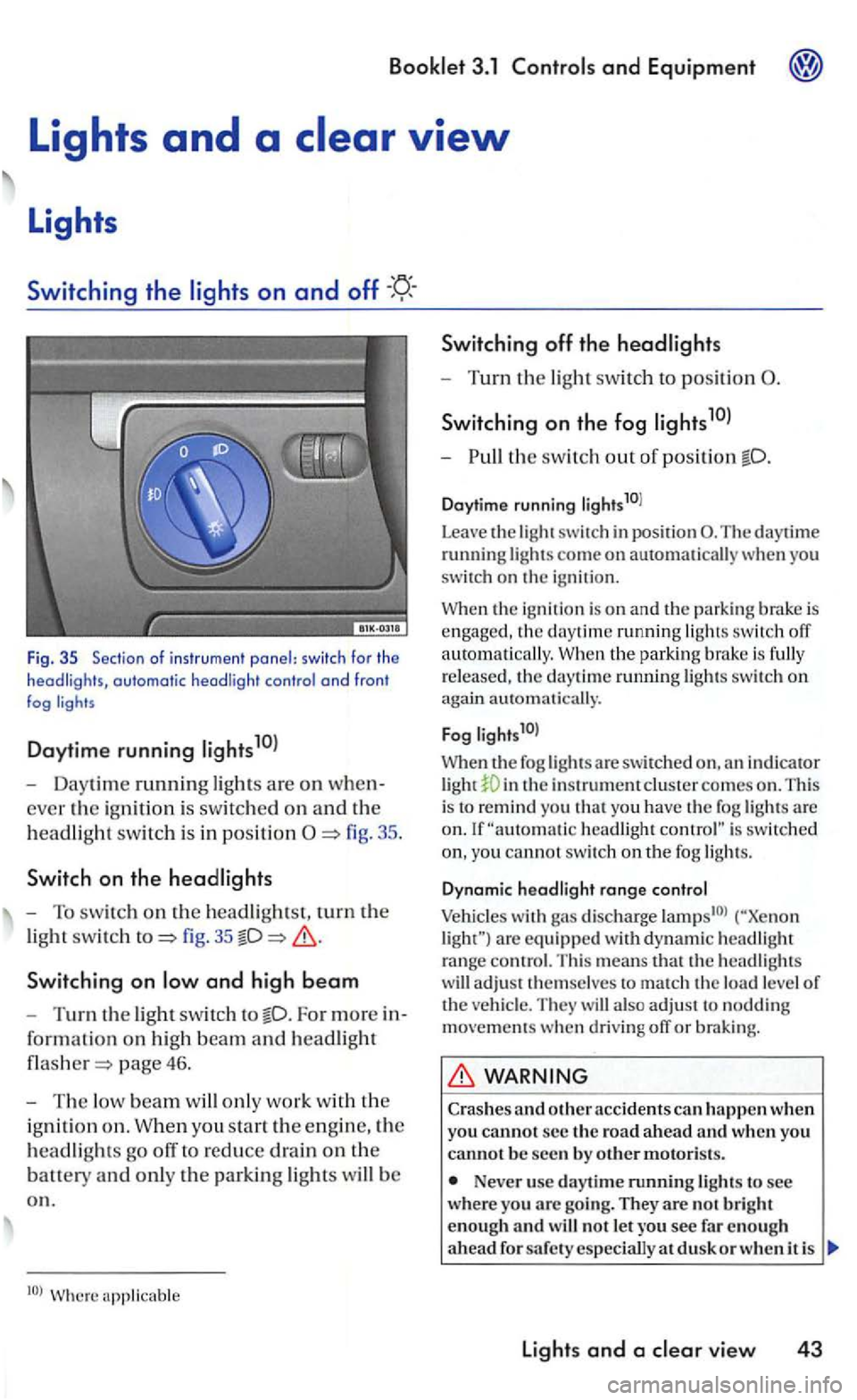
and Equipment
Fig . 35 Sec tio n of i nstr u m ent panel: switc h fo r th e headligh ts, automatic headli ght contro l a nd fron t fog
Daytime running
- Daytime running ligh ts are on when
ever the ig ni tio n i s sw itc hed on an d th e
h
eadlig ht swit c h i s in positi on
fig. 35
Switchin g on
For more in
for ma
tion on hig h beam an d headlight
page 46.
-The low beam w ill only work w it h th e
i g ni
tion o n . W hen you sta rt the e ngin e, the
h
eadlights go off to reduce drain on the
batt ety an d only th e parkin g lights will b e
o n .
Switching off th e headlights
- Turn the light swit ch to position
S wi tch ing on the fog
-th e switch out o f position
Daytime running li g hts10l
Leave
the light switch in posit ion The daytime running lights come on automatically you
switch on the igni tio n.
the ignition is o n and the parking brake is engaged , the daytime running ligh ts switch off
a uto m atically. the park in g bra ke is fully
r e leased , th e daytime ru nning lights swit c h on again automati cally.
F
og l ights1 0l
When th e fog lights a re swit ch ed in th e instrument clus te r comes on . This
i s to remind you t h at yo u have the fog lights are headlight is switc hed
yo u cannot switc h on th e fog ligh ts.
D ynam ic hea d light range co ntrol
Vehicles with gas discharge are eq uip ped w ith d yn am ic headlig h t range contro l. T his means that th e headlig hts
w ill adjust t hemselves to match th e load level of the ve hicl e. They will also ad ju st to noddin g movements when d riving off or braking.
WARNING
Crashes and o ther acc idents can h appen when you cannot s e c the ro a d a head and w hen you canno t b e seen by o th er motoris ts.
Never use day tim e running lights to see wher e you arc goi ng. They are no t b rig h t
enough an d w ill not le t you see fa r en o ug h
a head d usk o r w hen i t is
lights and a vie w 43
Page 260 of 444
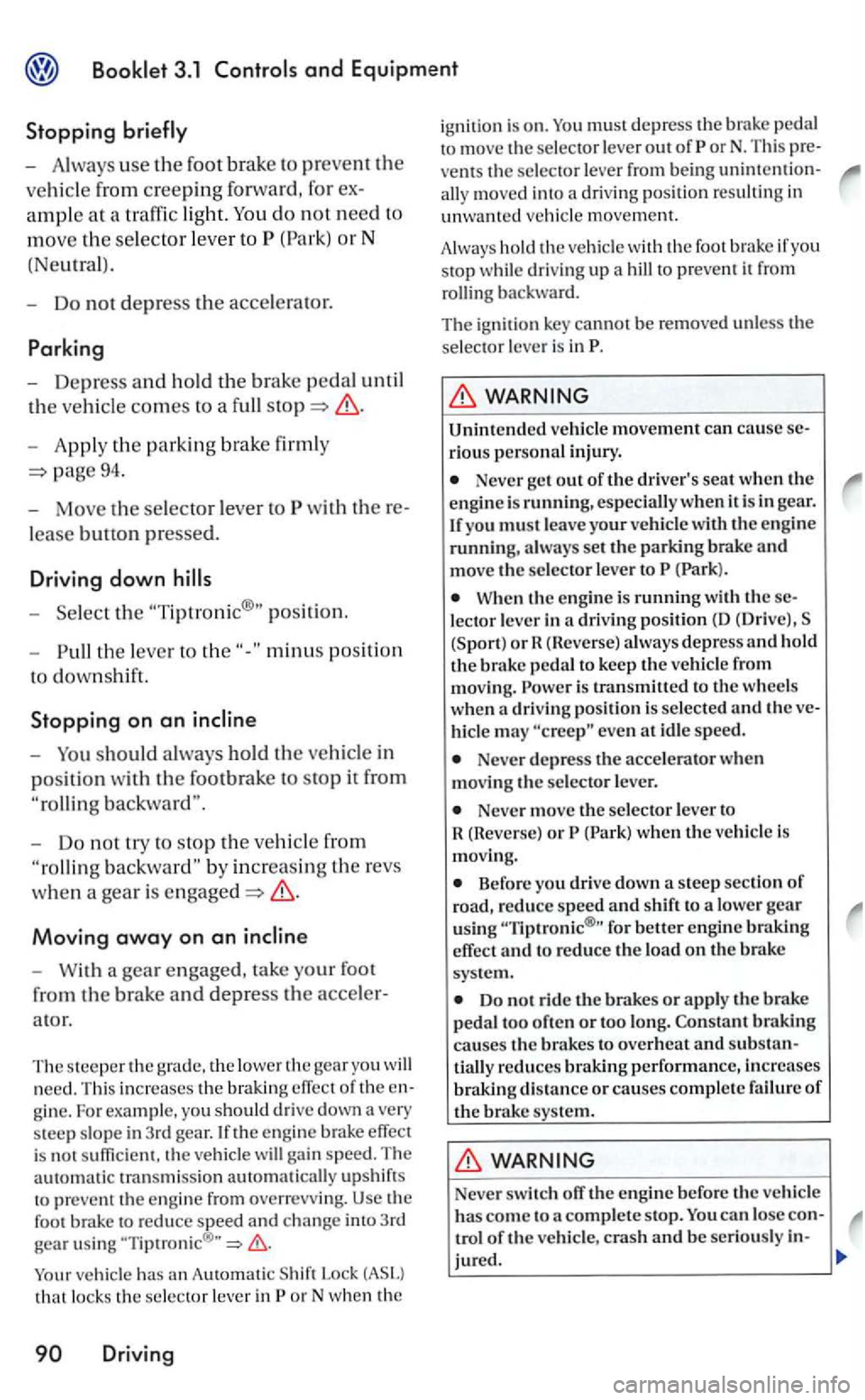
and Equipment
Stopping
-Alw ays use the foot brake to prevent the
vehicle from creeping forward , for
do not need to
move the selector leve r to (Park) or N
(Ne
utra l).
- Do not depress the accele rator.
Parking
- Depress and hold the brake pedal until
the vehicl e comes to a
- App ly the parking brake firmly
94.
- Mo ve th e
selector lever with
lease butto n pressed.
Driving dow n
-the position.
-
the lever to
-
- Do not try to stop the veh icle from
by increa sing the revs
w hen a
gear is
Moving a way on an
- W ith a gear engaged, tak e your foo t
f r o m
the brake and depress the
ator.
Th e stee per the grade, the lower the you will need. This increases the brakin g gine. For examp le, yo u sh ould drive down a very
s teep slop e in 3rd gear.lfthe engine brake is not s uffi cient. the vehicl e will gain spe ed . Th e tran smis sion automati cally up shift s
t o preve nt the engin e from the
foot brake to reduce speed and ch a nge into 3rd gear usin g 'Tiptronic®"
vehicl e has Automatic Sh if t Loc k (ASI.l that locks the selec tor lever in
must depre ss the brake pedal
t o move the selec tor lever out or N. Thi s
ally moved into a driving positi on result ing in unwante d ve hicle movement.
A lw a
ys ho ld th e vehicle with the foot if you
s top while driv in g up a hill to preve nt it fro m
rollin g backwa rd.
T he ig niti on
key ca nnot be remo ved unless the
s el ec tor lever is in
rious personal injury .
Never get out of the dri ver's seat when th e engin e is running, especially when it is in gear. If yo u must leave your vehicl e with the engine running, always set the parking brake and move the se lec tor lever (Pa rk).
When the engine is running with (Dri ve). (Sport) orR (Ileve rse ) a lways depress hold the brake pedal to keep th e ve hicl e from
m ov ing. is trans m i!!ed to the w heels
w hen a driving pos ition is selected even at idle speed.
Never depress th e accelerator when moving the selecto r lever.
Never move the selector lever to
R (Reverse) or whe n the vehicle is
m ov ing.
Before you drive down a steep section of road, reduce speed and shift to a low er gear usin g for better engin e braking effect and to reduce the load on the brake
sys te m.
Do not rid e the brakes or apply the brake pedal too often or too long. Constant braking
causes the brakes to overheat and tially reduces braking performance, increases braking dis tance or causes complete failu re of
the brake sys tem.
Never switch ofT the engine before the vehicle
h as come to complete s top. ca n lose con-trol of the ve hicle , crash and be serious ly in -
jured.
Page 264 of 444
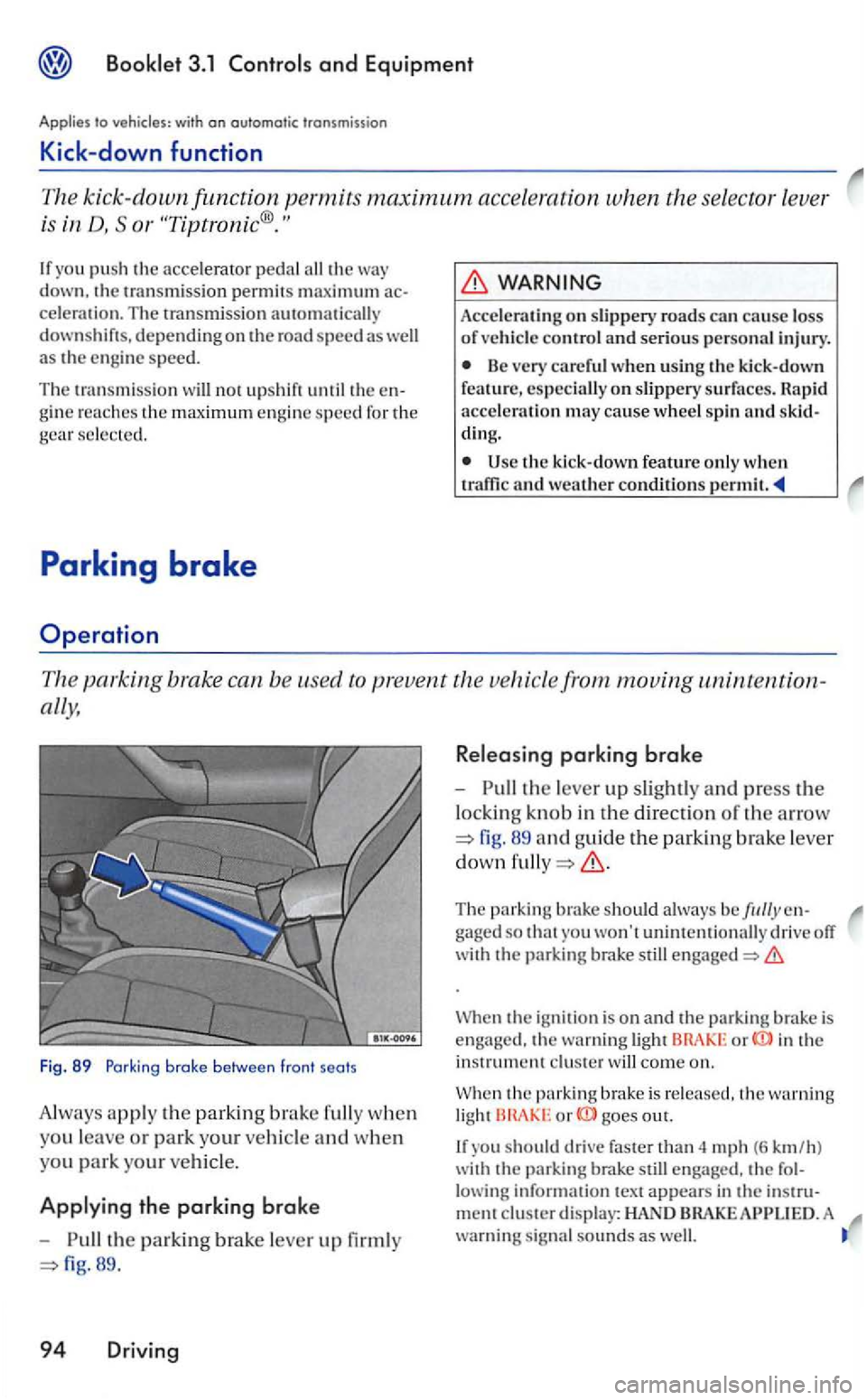
Booklet 3. 1 Controls and Equipment
Applies to v ehicle s: with on automatic trans m iss io n
Kick -down function
The kick-down funct ion permits maximu m acce leration when the selecto r lever
i s
g in e reac hes th e maximum engine speed for the gear sele c ted.
Parking brake
Operation
Accelcrat ing on slippery roads can cau se loss of ve hicl e contro l a n d serio u s personal inj u ry.
Be very care ful when using the kick-down feature, especia lly on sli ppery surfaces. Ra pid accele ra ti on m ay cause wheel spin and ding.
The parkin g brake can b e
the parking
and when
yo u park your
Applying th e parking broke
th e parking brake
89 .
94 Dri ving R
e
leasing parking broke
th e up and press the
kn ob in the d irect ion of th e a rrow
89 and guide the park in g brake
down
Th e brake should always be you wo n't unintentionally drive off
wi th the parkin g brake still
\Vhe n th e ignition is on and th e parking brak e is the wa rnin g light or in the
in strume nt clu ste r w ill come on.
or goes out.
If sh o uld drive fas ter th an 4 mph (6 km /h )
wi th th e parking brake still enga ged, the fol-
lowin g inform ation tex t appears in the m ent cluste r d is pla y: BRAKE A warning signal sounds as well.
Page 265 of 444
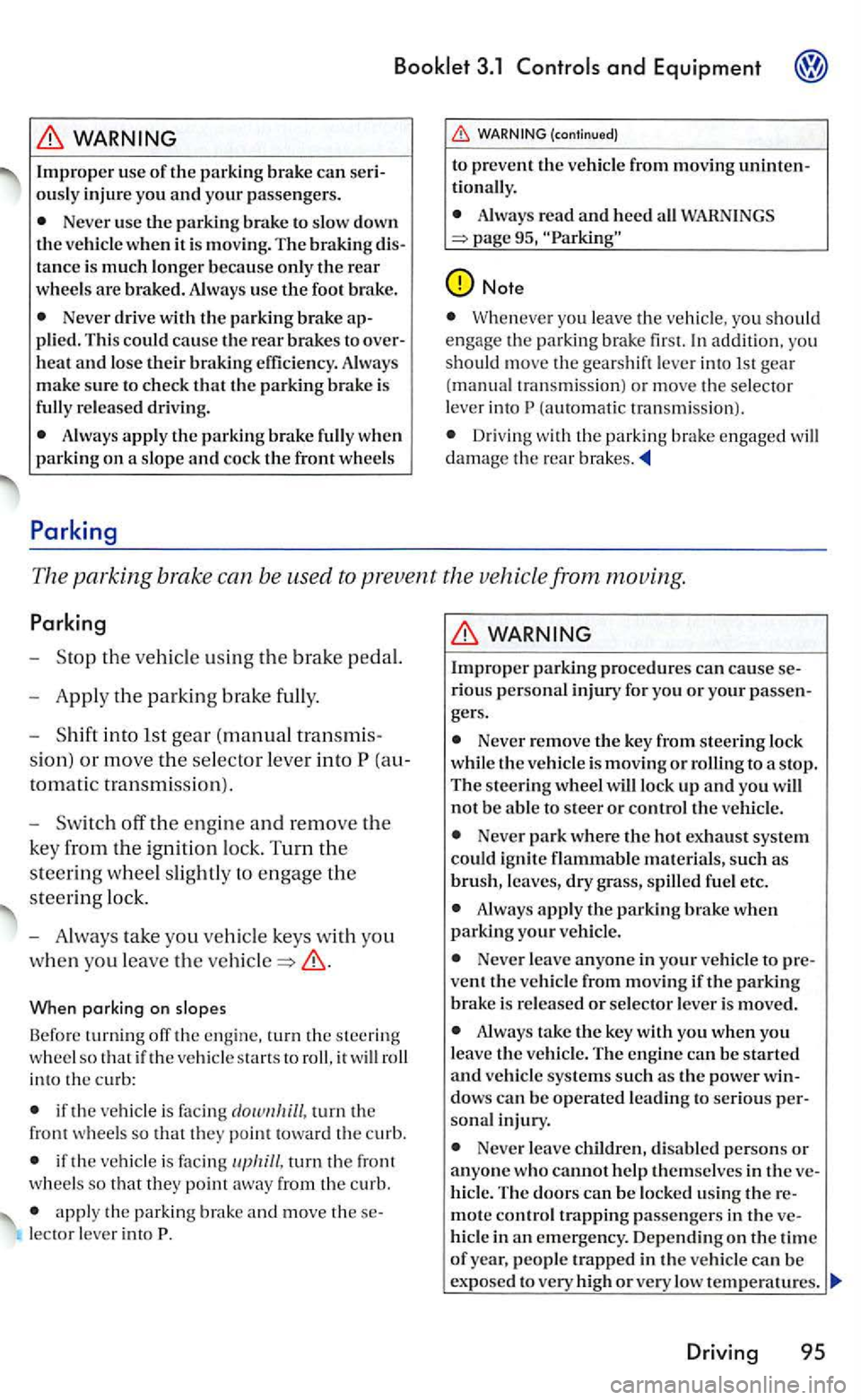
Booklet 3.1 Controls and Equipment
WARNING
Improper use of the parking brake can seri
ousl y injur e yo u and your passenge rs.
Neve r use the parking brake to slo w down
th e ve hicle when it is mov ing. The braking tanc e is much longer because only the rear wheel s are braked. Alwa ys use the foot brake.
Neve r drive with the parking brake plied. This could cause the rear brakes to overheat and los e their braking efficiency. Always
make sure to check that the parkin g is
fully re le a sed dri vin g.
Always apply the parking brake fully when
parking on a slope and cock the front wheels
Parking
(co ntinue d)
to prevent the vehicle from moving
Always read and h ee d WARNINGS
Whe never you leave th e veh icle, you should engage the parkin g
(aut om ati c tra nsm ission) .
Driving w ith the parking brake engaged will damage the rear
The parking bra ke can be used to prevent th.e vehicle from moving.
Parking
-the vehicle using the brake
-Apply th e parkin g brake full y.
-
into lst gear (m anual transmi s
sio n)
or move the se lector lever into
When parking on slo pes
Before turn ing off the engine, turn the steering
w hee l so that if th e vehicle starts roll, it will roll into the curb:
if the vehicle is facing turn the
f ront wheels so that they point toward the curb.
if th e veh ic le is facin g
apply the parkin g brake and m ove theselector leve r into
WARNING
Improper parki ng procedures can cause riou s personal injury for yo u or your passe n
gers.
Neve r remove the key from steering lock
while the ve hicl e is moving or rolling to a s top . The steering wheel will lock up and yo u will not be abl e to steer or contro l th e vehicle.
Neve r park where the hot exhaust system could ig nit e flammable materi als, such as brush, leaves, dry g ra ss, spill ed fue l e tc.
A lwa ys apply the parking brake when parking your vehi cle.
Neve r leave anyone in your vehi cle to vent the ve hicle from movin g if the parking brake is released or selector lever is moved.
Always take th e key with yo u when you leave the vehicle. The engin e ca n b e started and veh icle syste m s s uch as the powe r dows can be operated leadi ng to serious sonal injury.
Neve r leave childre n, disabl ed person s or anyone w ho cannot h elp th e mselves in the hicle. The doors can be locked using th e re-
m ote control trapping passe ngers in the h icle in an emerge ncy . Depending on the tim e of year, peo ple trapped in th e vehicle can be ex po sed to very high or very low temperatures.
Driving 95
Page 270 of 444
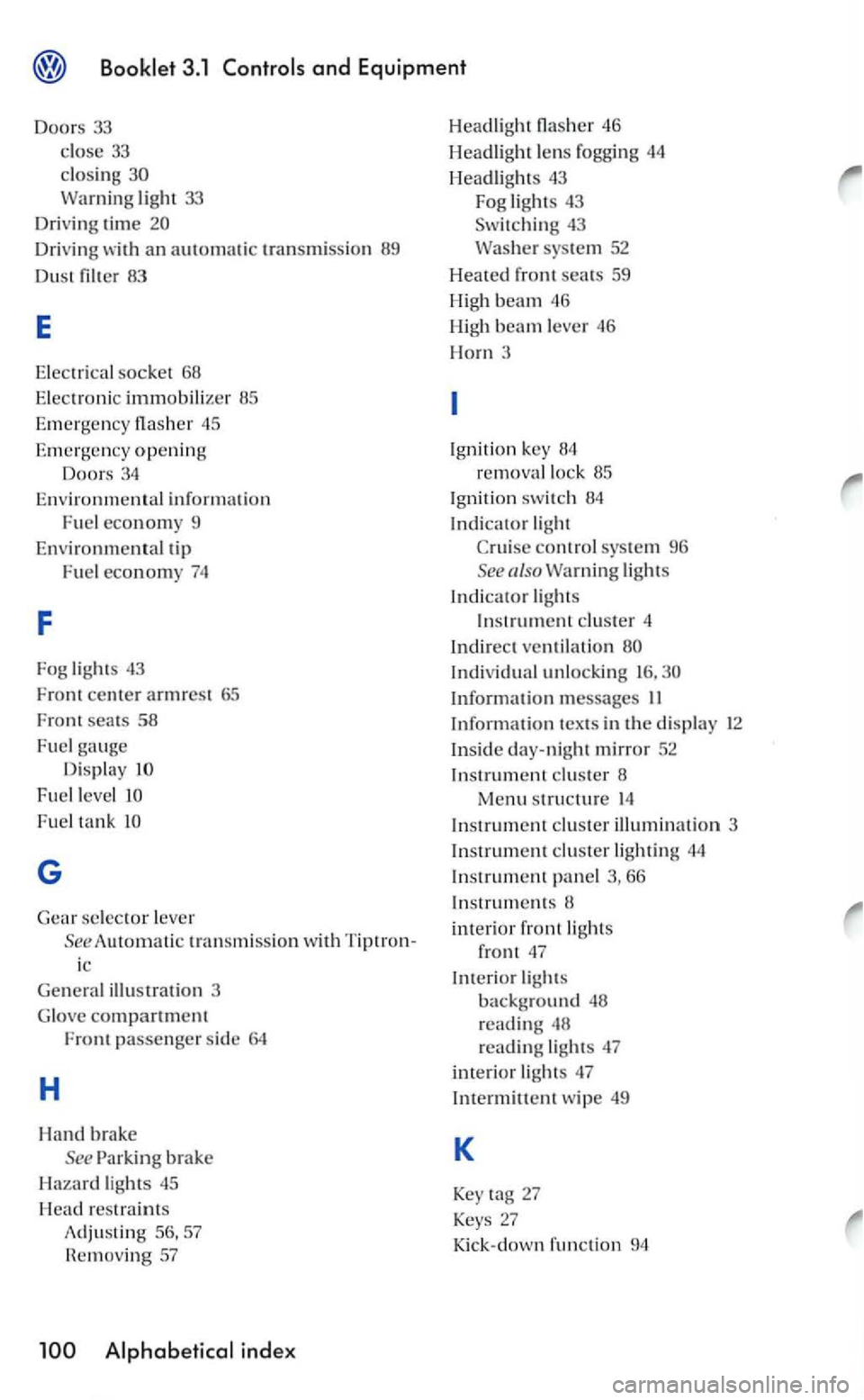
light 33
Dri v
ing time
Dri vin g wi th an t rans missio n 89
Du st filter 83
E
E le c trical socket 68
E l
ectro n ic immobilizer 85
Emergency fla sh er 45
Emergen cy opening
Doors 34
Env
ironme n tal informatio n
Fuel econom y 9
Environmen tal tip
Fuel economy 74
F
Fog light s 43
Front center armrest 65
Front seats 58
Fuel gauge Display
Fuel level
F u el ta n k
G
Gear se lector lever
See A
utomatic trans m ission wit h Tip tron
ic
illu stration 3
G l
ove compartment Front passenger sid e 64
H
Hand brake
See Parking brake
Hazard lights 45
H
ead restraints
Adjusting 57
R em
oving 57
46
Headlight lens fogging 44
Headlights 43
Fog
lights 43 Switching 43
syste m 52
H
eated f r ont seats 59
H ig h
beam 46
High
beam lever 46
Horn 3
I g niti on key
removal lock 85
I gni ti
on switch 84
Indicator light
control sy stem 96
See also
Indi vid ual unlocking
In formati o n messages
66
In struments
inte rio r front lights
front '1 7
Interio r lights
backg round 48
reading 48
readin g lig ht s 47
imerio r ligh ts 47
In te
rmitt ent wipe 49
K
Key 27
Keys 27
Kick-down functi on 94
Page 271 of 444
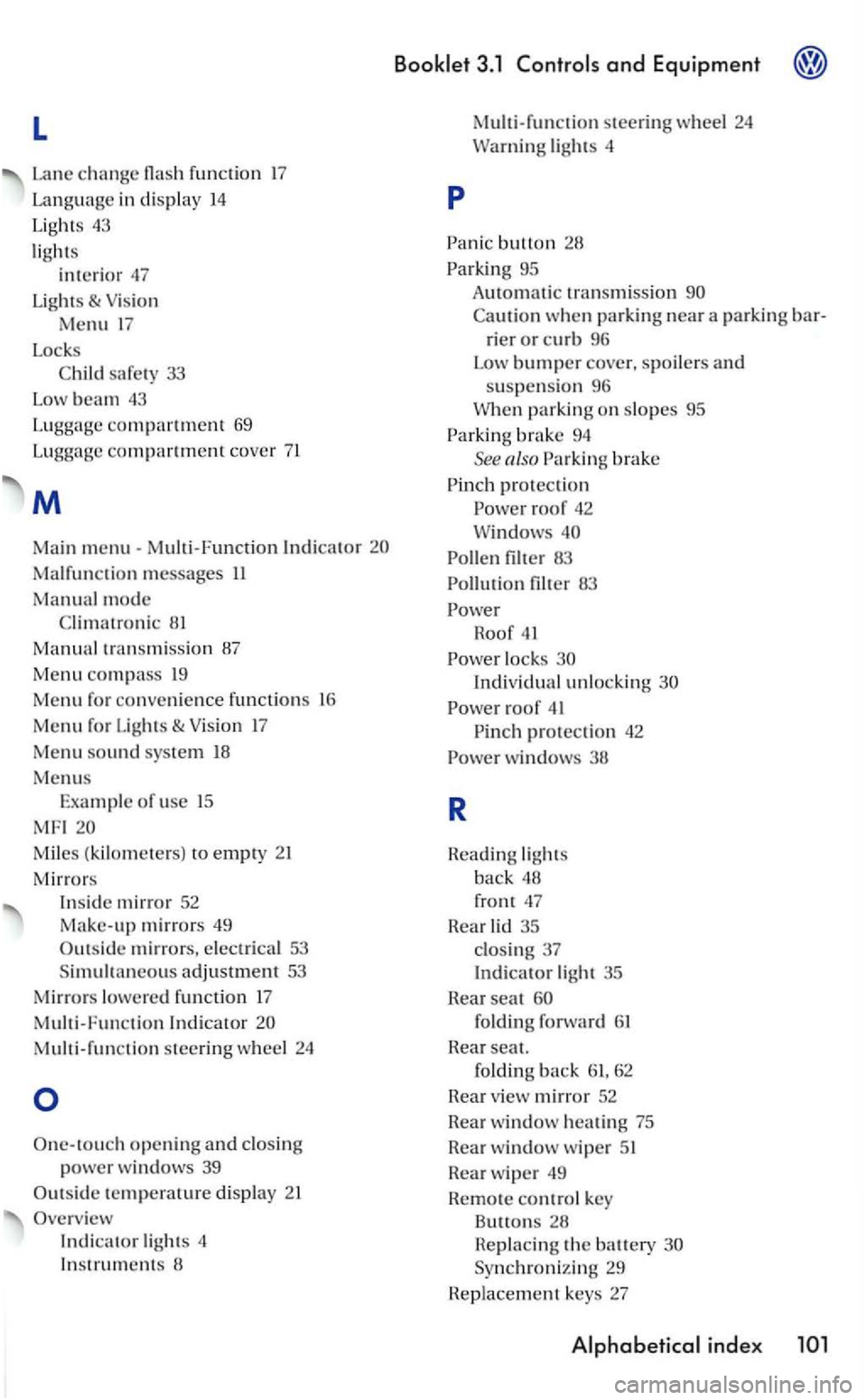
L
Lane c hange function
Language in display 14
L ight s 43
lights interior 47
Lights & Vision
Menu
Locks
Child
safety 33
M
Main menu-Multi-Funct io n
Malfun ction messages
Manual mode C limatronic
Manual tra n sm issio n
Menu compass 19
Menu fo r conven ience fu nctions 16
Menu for Lights & V isio n 17
Menu sound system
Menus
Exam ple of use 15
MFl
mirrors, electrical 53
Sim ultaneous adjustmen t 53
Mirrors lower ed function 17
M
ulti- Fun ction
Multi-fun cti on steering wheel 24
opening an d closing
power windows 39
Indica to r lights 4
button
bumper cove r. spoilers an d
s u spe nsi
on 96
When parking on slopes 95
brake 94
See also brake
p rotection roof 42
Windows
filter
filte r
loc ks lndividualunlocking
roof 41
p rotec tion 42
windows 38
R
Reading lights
back
47
Rear 35
clo sing 37 Indicator light 35
Rear seat folding forwa rd 61
Rear seat.
folding ba ck 61. 62
Hear view mirror 52
Hear window heating 75
Hear window wipe r 51
Rear wiper 49
Remot e control ke y
B u
ttons Repl acing th e battery
ind ex
Page 278 of 444

3.2 Tips and Advice
Smart technology
Brakes
Brake booster
The brake booster increases th e brake pre ssure
yo u pu t on th e brak e pedal. works only whe n the engi ne is running.
t h e brake booster is not working or if the hi cle to be tow ed. you will have to push the
b rake pedal harder to mak e up fo r the lack of boos ter assistance.
Braking with out the brake booste r needs much lon ger braki ng distanc e and requires
Warning
the brake pad wear indicator only tors th e front brake pads, the rear brak e pads in spected the sam e time.
There may be m essage in the in strument clu ste r inform ing yo u or advis ing yo u of the essary action to
(co ntinue d)
you to push the brake ped al harder tha n normal.
Never le t the ve hicle coast w ith the engine sw itch ed off.
ample if the vehicle is being towed, you will
have t o pus h the brake pedal much harder than
Driv in g with bad can cause collis ion a nd seriou s persona l injury.
the brake pads in specte d ate ly by an au thorize d Volk swagen d ealer or qualified works ho p if the brake pads worn symbo l l ights
Warning Brake system BRAKE or ((D)
The if parking brake is applied, if th e
the brake system .
This warning light BRAKE or up if:
The park ing brake is booklet and c h a pter "Parkin g th e ve hicle is dri ven faste r than about 4 m ph (6 km/h) with th e parkin g brake a warning sound. There may be message in the ins tru ment clus te r info rmin g yo u or vis ing yo u of the necessa ry action t o
If the brak e flui d leve l is too page 53.
2 Smart
If there is a m alfunction in the brake system , the warni ng in the instrument cluste r will comes on. You also
th e ve hicle and do not continu e to dri ve. Contact yo ur authorized swage n dealer or a qualified work shop. th ere is failur e, the indicator ligh t comes
Page 294 of 444

Booklet 3.2 Tip s and Advice
vehicl e handles diff ere ntl y wh en towin g a
tr ai ler because of the additional weigh t and weight distribution. Safe ty, pe rform ance and econo m y will greatl y depend on how carefull y
yo u load your trailer and op erat e your rig.
Before you actually to w your trail er, p ractic e
turning. stopping and b ack ing up in an area away from traffic until learn the feel of your vehicle and trail er unit.
Backing
up i s diffi cult and requi res practi ce.
Stee rin g whil e backing up is gen erall y opposite of that when backin g your vehicl e with out a
trailer.
Keep
more distance between your vehicl e and the one in front of yo u. will need more room to stop.
To compensate for the trail er. you will need a
larger than normal turning radius.
When passing, remember that you cannot erate as fast as you normally would because of the added load. Make sure yo u have enough
room to pass. After passing. allow plenty of room for you r trailer before c hanging lanes again.
Avoid je rk y s tart s, sharp turn s or rapid lan e changes.
Parking
After parking. always block th e wheels of both ve hicl e and trail er. Do not park with a traile r on a slope. If it cannot be a voided, do so only after doing th e follo wing:
Apply fo ot brake .
Have someone place chocks under both hicl e and trail er whee ls .
With the c hock s in place, s lo w ly re lease brak es until wheel blo cks absorb the load.
Turn w heels to curb (ve hicl e facing downhill)
o r to the stre et (when facing uphill).
Appl y parkin g brak e firmly.
automatic transmi ssion in
If you move the selecto r leve r of the automatic tran smission to
position.
Restarting
When restarting after parkin g on a slop e, reverse
the proc edure:
S tart the engine.
S hift transmission into gear.
le a se the parking brake and slowly move away from the wheel block s.
Stop and hav e someone re trie ve the wheel
b lock s.
Note
Neve r to w trailer during the break-in period of your vehicl e.
If yo u tow a trailer , yo ur Volksw age n m ay quire more frequent maimenance due to the
ext ra load.
Always check local reg ulations regardi ng
trailer to w in g.
Applies to vehicles: with anti-theft a larm system and a traile r towing set
Linking your trailer to the vehicle's anti-theft alarm system
The anti-theft alarm syste m will be triggere d as soon as the ele ctrical connec tion
between the trailer
and
or qualified
wo rkshop, if you want to inte grat e your trai le r to th e ve hicle's anti-theft a larm
Connecting your trailer to the anti-theft alarm syste m
If yo u ve hicle was built to include both the th eft al arm system and a trailer towin g th en t he trail er towing package (if available) is
in tegrated into the anti-theft alarm sys te m . Thi s
18 Driving and protecting the environment